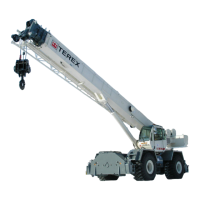Advance the throttle only enough to handle the load,
yet be certain that the engine speed is high enough to
maintain adequate fan speed for cooling.
Run the engine only when engaged in work opertions
or when traveling the crane. Avoid prolonged periods
at idle and shut the engine down if operations are inter-
rupted.
SANDY OR DUSTY WORK SITES The presence of
large amounts of sand or dust at the work site can con-
tribute to accelerated component wear. Either sub-
stance will act as an abrasive when deposited on
moving parts of the crane. The problem is combated by
more frequent lubrication and by the servicing of
breathers and filters at shorter intervals. Follow the
recommendations below when operating in sand or
dust on a regular basis.
1. Keep sand and dust out of the hydraulic system by
keeping the reservoir filler cap tight and servicing
the hydraulic system filters frequently.
2. The fuel system should be kept free of sand and
dust by keeping the tank filler cap tight and servic-
ing the fuel filters frequently.
3. The engine breathers and air cleaner should also be
serviced frequently to prevent sand and dust from
entering the engine. The engine oil and oil filter
should be changed at shorter than normal intervals
to ensure a clean oil supply to the engine’s moving
parts.
4. When lubricating the crane, thoroughly clean each
grease fitting before attaching the grease gun.
Pump generous amounts of grease into all lubrica-
tion points, using the fresh grease to pump out the
old.
5. Adequate ground bearing support must be provided
for the outrigger floats when operating in sand. Be
alert for signs of carrier movement during opera-
tions.
The increased frequency of lubrication and service dis-
cussed above should be determined by observations
made at the work site. Inspection will determine how
long it takes for lubricants, breathers and filters to ac-
cumulate unacceptable amounts of sand or dust. The
frequency of lubrication and service should be adjust-
ed accordingly.
HIGH HUMIDITY OR SALTWATER In some loca-
tions, such as coastal areas, the crane may be ex-
posed to the deteriorating effects of salt, moisture, or
both. To protect exposed metallic surfaces, wiring,
hoist rope, paint and other items, keep them dry and
well lubricated where salt or high humidity are encoun-
tered. Follow the recommendations below when oper-
ating in these conditions:
1. Make frequent inspections for rust and corrosion
and remove them as soon as they are detected. Dry
and paint exposed surfaces after rust and corrosion
have been removed.
2. Where paint may not be applied, such as on pol-
ished or machined surfaces, coat the area with
grease or lubricant to repel water.
3. Keep bearings and their surrounding surfaces well
lubricated to prevent the entry of water.
4. Hoist rope must be kept well lubricated to prevent
moisture and salt from penetrating the cable
strands.
HIGH ALTITUDES Variations in altitude alter the fuel-
air mixture burned in the engine and affect the engine’s
performance. At high altitudes, atmospheric pressures
are lower and less oxygen is available for combustion
of the fuel. Above 10,000’ the engine fuel injectors may
have to be changed to ensure proper performance.
Consult engine manufacturer should this problem
arise.
Keeping the air cleaner clean and free of obstructions
will help alleviate high altitude problems.
At high altitudes, closely monitor the engine tempera-
ture for overheating.
STORMS
In case of storms, take the following precautions:
- If possible, support the load and completely retract
the boom.
- If caught by a sudden storm, switch off the engine
and leave the machine.
- If the machine is struck by lightning, check general
machine operation before restarting it.
You must always know the weather forcasts of your
area before starting work.
OPERATING PROCEDURES
Revised: October 20053 - 22RT700

